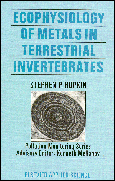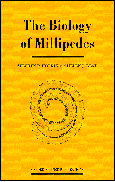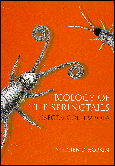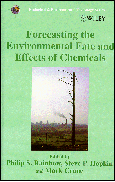|
Contract reports
WEEKS, J.M., HOPKIN, S.P., WRIGHT, J.F., BLACK, H., EVERSHAM, B.C., ROY, D. & SVENDSEN, C. (1998). A Demonstration of the Feasibility of SOILPACS. Environment Agency, London, 186pp. (ISBN 1-187360895).
Selected popular articles
HOPKIN, S.P. (1998). Collembola : the most abundant insects on earth. Antenna, 22, 117-121.
FRAMPTON, G. & HOPKIN, S.P. (2001). Springtails - in search of Britain's most abundant insects. British Wildlife, 12, 402-410.
HOPKIN, S.P. (2003). Photographing insects. Antenna, 27, 152-158.
HOPKIN, S.P. (2003). Woodlice, chiselbobs and sow-bugs. British Wildlife, 14, 381-387.
HOPKIN, S.P. (2004). Millipedes. British Wildlife, 16, 77-84.
HOPKIN, S.P. (2006). Centipedes. British Wildlife, 18, in press.
Selected refereed papers
(click on the underlined references to download a pdf file)
NOEL, H.L., HOPKIN, S.P., HUTCHINSON, T.H., WILLIAMS, T.D. & SIBLY, R.M. (2006). Population growth rate and carrying capacity for springtails Folsomia candida exposed to Ivermectin. Ecological Applications, 16, 656-665.
NOEL, H.L., HOPKIN, S.P., HUTCHINSON, T.H., WILLIAMS, T.D. & SIBLY, R.M. (2006). Towards a population ecology of stressed environments: the effects of zinc on the springtail Folsomia candida. Journal of Applied Ecology, 43, 325-332.
FOUNTAIN, M.T. & HOPKIN, S.P. (2005). Folsomia candida (Collembola): a 'standard' soil arthropod. Annual Review of Entomology, 50, 201-222.
FOUNTAIN, M. & HOPKIN, S.P. (2004). A comparative study of the effects of metal contamination in Collembola in the field and in the laboratory. Ecotoxicology, 13, 573-587.
FOUNTAIN, M. & HOPKIN, S.P. (2004). Biodiversity of Collembola in urban soils and the use of Folsomia candida to assess soil 'quality'. Ecotoxicology, 13, 555-572.
HOPKIN, S.P. (2002). Collembola. In : R. LAL (Ed.) Encyclopaedia of Soil Science. Marcel Dekker, New York, pp. 207-210.
HOPKIN, S.P. & SPURGEON, D.J. (2001). Forecasting the environmental effects of zinc, the metal of benign neglect in soil ecotoxicology. In : RAINBOW, P.S., HOPKIN, S.P. & CRANE, M. (Eds.) Forecasting the Fate and Effects of Toxic Chemicals, John Wiley, Chichester, pp. 91-96.
FOUNTAIN, M.T. & HOPKIN, S.P. (2001). Continuous monitoring of Folsomia candida (Insecta : Collembola) in a metal exposure test. Ecotoxicology and Environmental Safety, 48, 275-286.
SPURGEON, D.J., SVENDSEN, C., RIMMER, V.K., HOPKIN, S.P. & WEEKS, J.M. (2000). Relative sensitivity of life-cycle and biomarker responses in four earthworm species exposed to zinc : Environmental Toxicology and Chemistry, 19, 1800-1808.
SCOTT-FORDSMAND, J.J., WEEKS, J.M. & HOPKIN, S.P. (2000). Importance of contamination history for understanding toxicity of copper to earthworm Eisenia fetida (Oligochaeta : Annelida), using the neutral-red retention assay. Environmental Toxicology and Chemistry 19, 1774-1780.
SPURGEON, D.J. & HOPKIN, S.P. (2000). The development of genetically inherited resistance to zinc in laboratory selected generations of the earthworm Eisenia fetida. Environmental Pollution, 109, 193-201.
SPURGEON, D.J. & HOPKIN, S.P. (1999). Tolerance to zinc in populations of the earthworm Lumbricus rubellus from uncontaminated and metal-contaminated ecosystems. Archives of Environmental Contamination and Toxicology, 37, 332-337.
SPURGEON, D.J. & HOPKIN, S.P. (1999). Comparisons of metal accumulation and excretion kinetics in earthworms (Eisenia fetida) exposed to contaminated field and laboratory soils. Applied Soil Ecology, 11, 227-243.
SCOTT-FORDSMAND, J.J., KROGH, P.H. & HOPKIN, S.P. (1999). Toxicity of nickel to a soil-dwelling springtail Folsomia fimetaria (Collembola : Isotomidae). Ecotoxicology and Environmental Safety, 43, 57-61.
SPURGEON, D.J., HOPKIN, S.P. (1999). Seasonal variation in the abundance, biomass and biodiversity of earthworms in soils contaminated with metal emissions from a primary smelting works. Journal of Applied Ecology, 36, 173-183.
SPURGEON, D.J. & HOPKIN, S.P. (1999). Life-history patterns in metal-exposed populations of the earthworm Lumbricus rubellus. Ecotoxicology, 8, 133-141.
SCOTT-FORDSMAND, J.J., WEEKS, J.M. & HOPKIN, S.P. (1998). Toxicity of nickel to the earthworm and the applicability of the neutral red retention assay. Ecotoxicology, 7, 291-295.
HOPKIN, S.P. (1998). Laboratory to field extrapolation of 'standard' ecotoxicological tests for soil animals. Cuadernos de Investigación Biológica (Bilbao), 20, 33-36.
JONES, D.T. & HOPKIN, S.P. (1998). Reduced survival and body size in the terrestrial isopod Porcellio scaber from a metal-polluted environment. Environmental Pollution, 99, 215-223.
SANDIFER, R.D. & HOPKIN, S.P. (1997). Effects of temperature on the relative toxicities of cadmium, copper, lead and zinc to Folsomia candida Willem, 1902 (Collembola) in a standard laboratory test system. Ecotoxicology and Environmental Safety, 37, 125-130.
HOPKIN, S.P. (1997). Ecotoxicology, biodiversity and the species concept with special reference to springtails (Insecta : Collembola). In: VAN STRAALEN, N.M. & LOKKE, H. (Eds.) Ecological Principles for Risk Assessment of Contaminants in Soil. Chapman & Hall, London & New York. pp. 73-83.
SPURGEON, D.J., TOMLIN, M.A. & HOPKIN, S.P. (1997). Influence of temperature on the toxicity of zinc to the earthworm Eisenia fetida. Bulletin of Environmental Contamination and Toxicology, 58, 283-290.
JONES, D.T. & HOPKIN, S.P. (1996). Reproductive allocation in the terrestrial isopods Porcellio scaber and Oniscus asellus in a metal polluted environment. Functional Ecology, 10, 741-750.
SANDIFER, R.D. & HOPKIN, S.P. (1996). Effects of pH on the toxicity of cadmium, copper, lead and zinc to Folsomia candida Willem, 1902 (Collembola) in a standard laboratory test system. Chemosphere, 33, 2475-2486.
SPURGEON, D.J. & HOPKIN, S.P. (1996). Effects of metal-contaminated soils on the growth, sexual development and early cocoon production of the earthworm Eisenia fetida with particular reference to zinc. Ecotoxicology and Environmental Safety, 35, 86-95.
SPURGEON, D.J. & HOPKIN, S.P. (1996). The effects of metal contamination on earthworm populations around a smelting works : quantifying species effects. Applied Soil Ecology, 4, 147-160.
LASKOWSKI, R. & HOPKIN, S.P. (1996). Effects of Zn, Cu, Pb and Cd on fitness in snails (Helix aspersa). Ecotoxicology and Environmental Safety, 34, 59-69.
SPURGEON, D.J., SANDIFER, R.D. & HOPKIN, S.P. (1996). The use of macro-invertebrates for population and community monitoring of metal contamination : Indicator taxa, effect parameters and the need for a Soil Invertebrate Prediction and Classification Scheme (SIVPACS). In: VAN STRAALEN, N.M. & KRIVOLUTSKY, D.A. (Eds.) Bioindicator Systems for Soil Pollution. Kluwer Academic, Dordrecht. pp. 95-110.
SPURGEON, D.J. & HOPKIN, S.P. (1996). Risk assessment of the threat of secondary poisoning by metals to predators of earthworms in the vicinity of a primary smelting works. Science of the Total Environment, 187, 167-183.
LASKOWSKI, R. & HOPKIN, S.P. (1996). Accumulation of Zn, Cu, Pb and Cd in the garden snail (Helix aspersa) : implications for predators. Environmental Pollution, 91, 289-297.
SPURGEON, D.J. & HOPKIN, S.P. (1996). Effects of variation of the organic matter content and pH of soils on the availability and toxicity of zinc to the earthworm Eisenia fetida. Pedobiologia, 40, 80-96.
HOPKIN, S.P. (1996). Myriapodology before and after Martin Lister's 'Journey to Paris in the Year 1698'. In: J.J. GEOFFROY, J.P. MAURIÈS & M. NGUYEN DUY-JACQUEMIN (Eds.) Acta Myriapodologica (Proceedings of the 9th International Congress of Myriapodology, Paris, July 1993). Mémoires du Muséum National d'Histoire Naturelle, 169, 25-34.
DEPLEDGE, M.H. & HOPKIN, S.P. (1995). Methods to assess effects on brackish, estuarine, and near-coastal water organisms. In: R.A. LINTHURST, P. BOURDEAU & R.G. TARDIFF (Eds.) Methods to Assess the Effects of Chemicals on Ecosystems. John Wiley, London. pp. 125-149.
DROBNE, D. & HOPKIN, S.P. (1995). The toxicity of zinc to terrestrial isopods in a standard laboratory test. Ecotoxicology and Environmental Safety, 31, 1-6.
SPURGEON, D.J. & HOPKIN, S.P. (1995). Extrapolation of the laboratory-based OECD earthworm toxicity test to metal-contaminated field sites. Ecotoxicology, 4, 190-205.
HOPKIN, S.P. (1995). Deficiency and excess of essential and non-essential metals in terrestrial insects. In: R. HARRINGTON & N.E. STORK (Eds.) Insects in a Changing Environment. Symposia of the Royal Entomological Society of London, 17, 251-270.
DROBNE, D. & HOPKIN, S.P. (1994). An ecotoxicological laboratory test for assessing the effects of chemicals on terrestrial isopods. Bulletin of Environmental Contamination and Toxicology, 53, 390-397.
JONES, D.T. & HOPKIN, S.P. (1994). Monitoring the accumulation of cadmium released from industrial sources. In: B. WIDIANARKO, K. VINK & N.M. VAN STRAALEN (Eds.). Environmental Toxicology in South East Asia. Free University Press, Amsterdam, pp. 315-321.
JONES, D.T. & HOPKIN, S.P. (1994). Effects of metals on the size of terrestrial isopods in an industrially polluted area. In: B. WIDIANARKO, K. VINK & N.M. VAN STRAALEN (Eds.). Environmental Toxicology in South East Asia. Free University Press, Amsterdam, pp. 191-197.
SPURGEON, D.J., HOPKIN, S.P. & JONES, D.T. (1994). Effects of cadmium, copper, lead and zinc on growth, reproduction and survival of the earthworm Eisenia fetida (Savigny) : assessing the environmental impact of point-source metal contamination in terrestrial ecosystems. Environmental Pollution, 84, 123-130.
HOPKIN, S.P. (1994). Effects of metal pollutants on decomposition processes in terrestrial ecosystems with special reference to fungivorous soil arthropods. In: S.M. ROSS (Ed.) Toxic Metals in Soil-Plant Systems. John Wiley, Chichester, 303-326.
HOPKIN, S.P. & HAMES, C.A.C. (1994). Zinc, among a 'cocktail' of metal pollutants, is responsible for the absence of the terrestrial isopod Porcellio scaber from the vicinity of a primary smelting works. Ecotoxicology, 2, 68-78.
HOPKIN, S.P., JONES, D.T. & DIETRICH, D. (1993). The isopod Porcellio scaber as a monitor of the bioavailability of metals in terrestrial ecosystems : towards a global 'woodlouse watch' scheme. Science of the Total Environment, 1993S, 357-365.
HOPKIN, S.P. (1993). Ecological implications of '95% protection levels' for metals in soil. Oikos, 66, 137-141.
HOPKIN, S.P. (1993). Deficiency and excess of copper in terrestrial isopods. In: R. DALLINGER & P.S. RAINBOW (Eds.) Ecotoxicology of Metals in Invertebrates. Lewis, Boca Raton, pp. 359-382.
HOPKIN, S.P. (1993). In situ biological monitoring of pollution in terrestrial and aquatic ecosystems. Chapter 20 in P. CALOW (Ed.) Handbook of Ecotoxicology, Volume 1. Blackwell Scientific, Oxford, pp. 397-427.
HOPKIN, S.P. & ANGER, H.S. (1992). On the structure and function of the glue-secreting glands of Henia vesuviana (Newport 1845) (CHILOPODA : GEOPHILOMORPHA). In: E. MEYER, K. THALER & W. SCHEDL (Eds.) Proceedings of the 8th International Congress of Myriapodology, Innsbruck, Austria, July 1990. Berichte des Naturwissenschaftenlich Medizinischen Vereins in Innsbruck, Supplementum 10, 71-79.
HAMES, C.A.C. & HOPKIN, S.P. (1991). A daily cycle of apocrine secretion by the B cells of the hepatopancreas of terrestrial isopods. Canadian Journal of Zoology, 69, 1931-1937.
HAMES, C.A.C. & HOPKIN, S.P. (1991). Assimilation and loss of 109Cd and 65Zn by the terrestrial isopods Oniscus asellus and Porcellio scaber. Bulletin of Environmental Contamination and Toxicology, 47, 440-447.
JONES, D.T. & HOPKIN, S.P. (1991). Biological monitoring of metal pollution in terrestrial ecosystems. In: O. RAVERA (Ed.), Terrestrial and Aquatic Ecosystems : Perturbation and Recovery. Ellis Horwood, Chichester, pp. 148-152.
HOPKIN, S.P. (1990). Critical concentrations, pathways of detoxification and cellular ecotoxicology of metals in terrestrial arthropods. Functional Ecology, 4, 321-327.
HOPKIN, S.P. (1990). Species-specific differences in the net assimilation of zinc, cadmium, lead, copper and iron by the terrestrial isopods Oniscus asellus and Porcellio scaber. Journal of Applied Ecology, 27, 460-474.
HOPKIN, S.P., GAYWOOD, M.J., VINCENT, J.F.V. & MAYES-HARRIS, E.L.V. (1990). Defensive secretion of proteinaceous glues by Henia (Chaetechelyne) vesuviana (Chilopoda, Geophilomorpha). In: A. MINELLI (Ed.), Proceedings of the 7th International Congress of Myriapodology, Vittorio Veneto, Italy, July 1987. E.J. Brill, Leiden, pp. 175-181.
HOPKIN, S.P., HAMES, C.A.C. & DRAY, A. (1989). X-ray microanalytical mapping of the intracellular distribution of pollutant metals. Microscopy and Analysis, 14, 23-27.
HAMES, C.A.C. & HOPKIN, S.P. (1989). The structure and function of the digestive system of terrestrial isopods. Journal of Zoology, 217, 599-627.
HOPKIN, S.P., HAMES, C.A.C. & BRAGG, (1989). Terrestrial isopods as biological indicators of zinc pollution in the Reading area, south-east England. Proceedings of the Second International Symposium on the Biology of Terrestrial Isopods, Urbino, Italy, September 1986. Monitore Zoologico Italiano (New Series), Monografia 4, 477-488.
COLLOFF, M.J. & HOPKIN, S.P. (1987). On the male of Bakerdania elliptica (Krczal, 1959) with a redescription of the female (Acari : Pygmephoridae). Acarologia, 28, 323-330.
HOPKIN, S.P. (1986). Ecophysiological strategies of terrestrial arthropods for surviving heavy metal pollution. In: H.H.W. VELTHUIS (Ed.) Proceedings of the Third European Congress of Entomology, Amsterdam, August 1986. Nederlandse Entomologische Vereniging, pp. 263-266.
COLLOFF, M.J. & HOPKIN, S.P. (1986). The ecology, morphology and behaviour of Bakerdania elliptica (Acari : Prostigmata : Pygmephoridae), a mite associated with terrestrial isopods. Journal of Zoology, 208A, 109-123.
HOPKIN, S.P., HARDISTY, G. & MARTIN, M.H. (1986). The woodlouse Porcellio scaber as a 'biological indicator' of zinc, cadmium, lead and copper pollution. Environmental Pollution, 11B, 271-290.
HOPKIN, S.P., WATSON, K., MARTIN, M.H. & MOULD, M.L. (1985). The assimilation of heavy metals by Lithobius variegatus and Glomeris marginata (Chilopoda; Diplopoda). Proceedings of the 6th International Congress of Myriapodology, Amsterdam, 12-17 April 1984. Bijdragen tot de Dierkunde, 55, 88-94.
HOPKIN, S.P. & MARTIN, M.H. (1985). Transfer of heavy metals from leaf litter to terrestrial invertebrates. Journal of the Science of Food and Agriculture, 36, 538-539.
HOPKIN, S.P. & MARTIN, M.H. (1985). Assimilation of zinc, cadmium, lead, copper and iron by the spider Dysdera crocata, a predator of woodlice. Bulletin of Environmental Contamination and Toxicology, 34, 183-187.
HOPKIN, S.P., MARTIN, M.H. & MOSS, S.M. (1985). Heavy metals in isopods from the supra-littoral zone on the southern shore of the Severn Estuary, U.K. Environmental Pollution, 9B, 239-254.
HOPKIN, S.P. & MARTIN, M.H. (1984). Heavy metals in woodlice. In : The Biology of Terrestrial Isopods, S.L. SUTTON & D.M. HOLDICH (Eds.). Symposia of the Zoological Society of London, 53, 143-166.
HOPKIN, S.P. & MARTIN, M.H. (1984). The assimilation of zinc, cadmium, lead and copper by the centipede Lithobius variegatus (Chilopoda). Journal of Applied Ecology, 21, 535-546.
AVERY, R.A., WHITE, A.S., MARTIN, M.H. & HOPKIN, S.P. (1983). Concentrations of heavy metals in common lizards (Lacerta vivipara) and their food and environment. Amphibia-Reptilia, 4, 205-213.
HOPKIN, S.P. & MARTIN, M.H. (1983). Heavy metals in the centipede Lithobius variegatus (Chilopoda). Environmental Pollution, 6B, 309-318.
HOPKIN, S.P. & MARTIN, M.H. (1982). The distribution of zinc, cadmium, lead and copper within the hepatopancreas of a woodlouse. Tissue and Cell, 14, 703-715.
HOPKIN, S.P. & MARTIN, M.H. (1982). The distribution of zinc, cadmium, lead and copper within the woodlouse Oniscus asellus (Crustacea, Isopoda). Oecologia, 54, 227-232.
HOPKIN, S.P. & NOTT, J.A. (1980). Studies on the digestive cycle of the shore crab Carcinus maenas (L.) with special reference to the B cells in the hepatopancreas. Journal of the Marine Biological Association of the United Kingdom, 60, 891-907.
HOPKIN, S.P. & NOTT, J.A. (1979). Some observations on concentrically structured, intracellular granules in the hepatopancreas of the shore crab Carcinus maenas (L.). Journal of the Marine Biological Association of the United Kingdom, 59, 867-877.
|
|















































